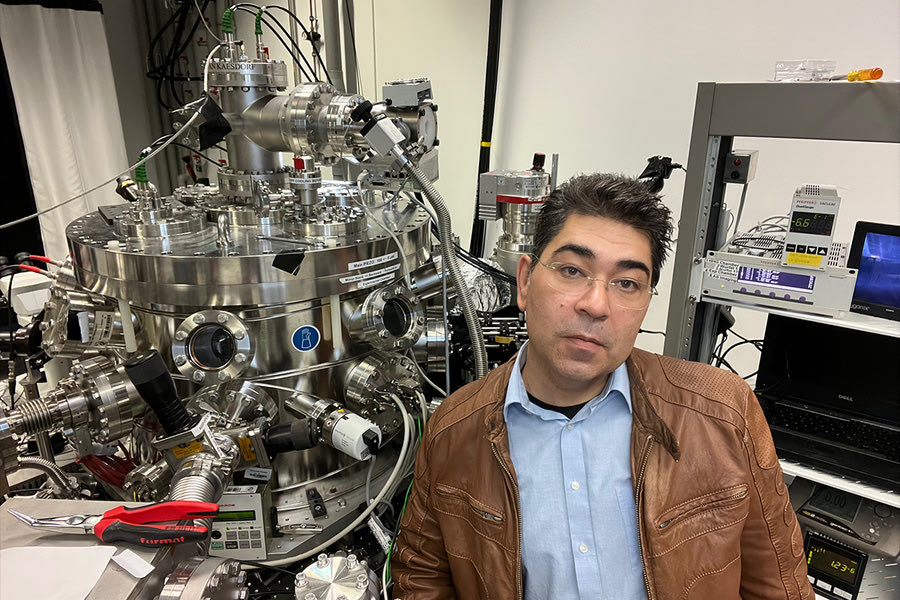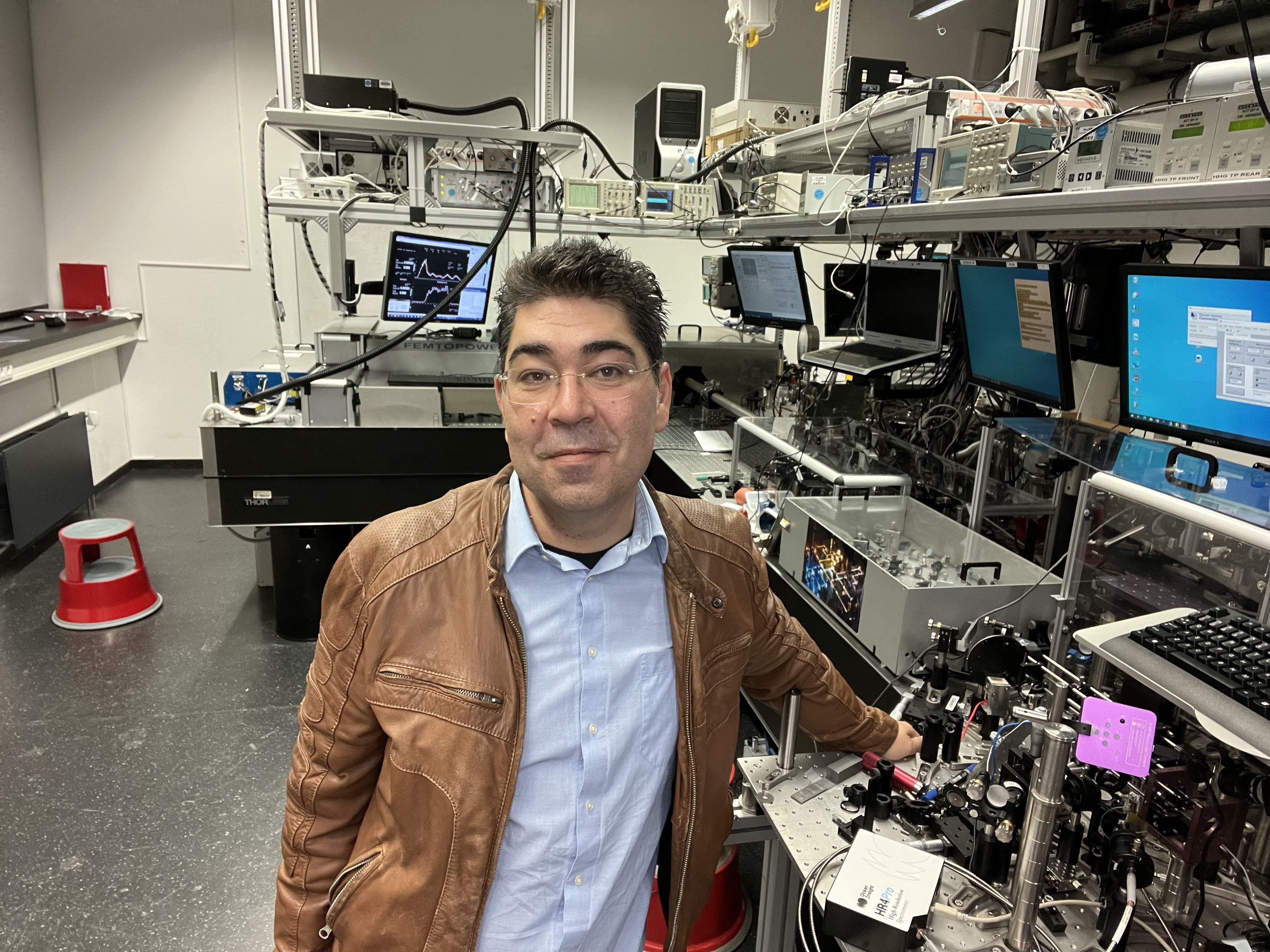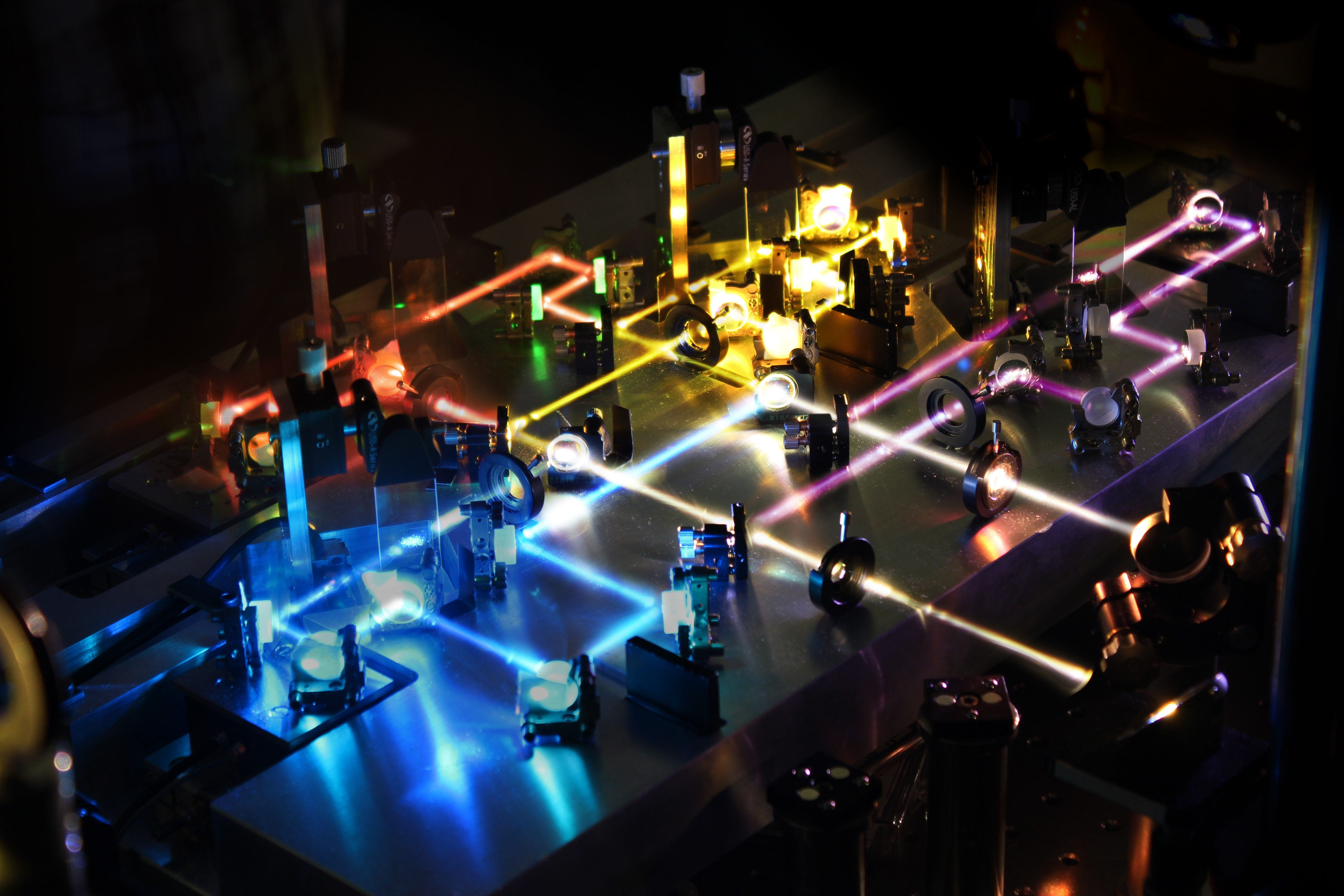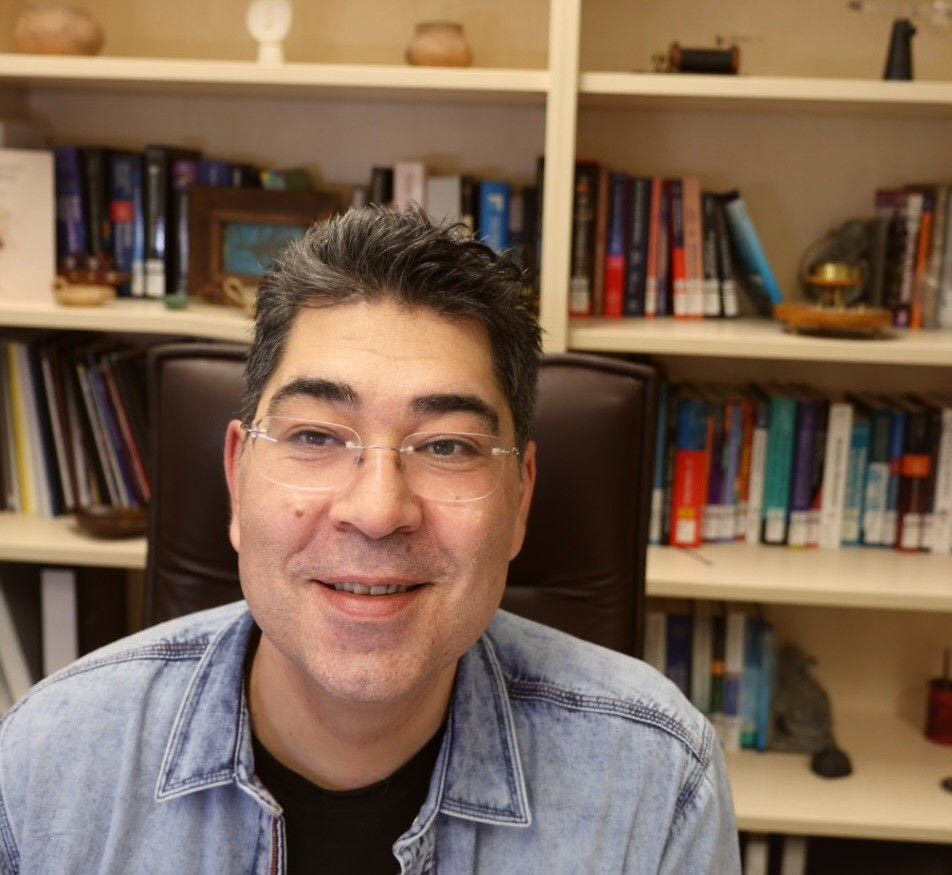In his lab, he works tirelessly, breaking new ground as he explores the strange realms of physics.
But when he wants to unwind, he creates mosaics, replicating the works of ancient artists, and writes humorous stories and mantinades—Cretan rhyming couplets—reflecting his Cretan roots and memories from his childhood and youth in the village of Pigaidakia.
We’re talking about Professor Lefteris Goulielmakis of the University of Rostock in Germany. Starting out from Crete, he embarked on a remarkable scientific journey that led to his global acclaim years ago. Known for his bold work on synthesizing light waves, Professor Goulielmakis shares his insights in this interview about his past achievements and future plans.
For him, Crete remains his foundation, while science is his goal. He points out, though, that scientists work tirelessly, fully aware that they may never reach their goal or receive recognition for their work. Goulielmakis himself, however, did gain recognition, collaborating closely with last year’s Nobel laureate, Ferenc Krausz.
His current research aims to unite two fields within his team: microscopy, which allows the capture of atomic-scale images, and the physics of ultra-fast pulses, which recently earned a Nobel Prize. He believes this combination is crucial for advancing our understanding of matter, benefiting other fields like materials science and biology. He uses X-rays, one of the simplest examples of applied physics, to illustrate just how much physics can offer humanity today.
He encourages young people to pursue their dreams and follow science if they find it fulfilling. “Only if you love what you do is it worth the effort,” he says. Otherwise, it will seem like just a hard job with little reward.
Regarding his lighthearted presence on social media, where he shares mantinades, images, and self-deprecating comments, he notes that if it brings a bit of laughter, it’s worth it. However, he also points out that social media is no longer a space for sharing ideas and thoughtful discussions.
The Typical, Long, and Challenging Path of Science
– From Crete to Director of the Extreme Photonics Team at the Institute of Physics, University of Rostock, Germany. How long was that journey?
“A long but fairly typical journey, I would say, for those walking the paths of science. Science is universal; it doesn’t belong to any one place. Those on its path must constantly adapt and seek ideal conditions to reach their scientific goals. This sometimes comes at a cost to one’s personal life. The only way to persevere is to truly love what you do.”
–You were a close collaborator of last year’s Nobel laureate Ferenc Krausz, and you continue to work in astrophysics. How do the findings from your research and that of your colleagues impact people’s everyday lives, and how can the public understand what you do?
“Our research involves studying rapidly evolving phenomena at a microscopic level—in other words, physical processes within materials where atoms and electrons play a central role. These processes are invisible to the naked eye and occur so quickly that no camera can capture them.
Our goal is to develop tools to make these processes visible and, more importantly, understandable. To someone without a scientific background, this might sound abstract and distant, as is often the case when discussing basic research. Why? Because basic research aims to lay the foundations for the technologies of the future, not for today.
It doesn’t address current technical problems. For example, if we want to develop faster and more efficient electronic devices, computers, mobile phones, and new technologies in healthcare, energy, and environmental protection, it’s essential to create increasingly smaller components within these devices.
Inevitably, we’ll eventually reach the scale of individual atoms, and then we’ll have no choice but to use the atoms themselves as units for processing information. The only way to achieve this is by deeply understanding how the world functions on a microscopic scale. It might seem strange that modern physics is building the technology of tomorrow, but in reality, that’s always been its role.
The technology we benefit from daily is based on ideas that were once the focus of basic physics research, often decades ago. Back then, no one could foresee the scope of these ideas’ applications—not even the scientists themselves. Every one of us who has had an X-ray has benefited from the invention Wilhelm Röntgen made in 1895, for which he received the first Nobel Prize in Physics—the so-called X-rays.
When journalists of the time asked him what applications his invention might have in daily life, Röntgen responded, ‘I don’t think it will have any.’ He was reportedly surprised when portable X-ray devices were used during World War I to locate bullets in wounded soldiers.”
–What is the current focus of your team’s research?
“The new major goal in the sciences of the microcosm is to combine two crucial fields of physics: microscopy—which allows us to capture images of atoms on a microscopic scale—and the physics of ultra-fast pulses, which recently received the Nobel Prize. This combination is now essential for making even greater strides in understanding matter, which will benefit fields like materials science and biology.”
The Composition of Light Waves That Made Him Famous
– You gained recognition in the scientific community at a very young age, and the first headlines about you read: “The Greek physicist who composes light waves.” What was this achievement, and how did you feel when the recognition came, obviously after hard work?
“This achievement involved synthesizing light waves to create extremely short light pulses, allowing us to explore phenomena at the atomic level with unprecedented temporal resolution. It was a risky venture at the start of my academic career, especially as previous attempts by other scientists had not yielded the desired results.
However, after years of work, the efforts paid off, and today we have tools that we couldn’t have even imagined twenty years ago. Recognition of our work is, of course, a great pleasure, but scientists are prepared for the possibility that it might never come. This is especially true in fundamental research, which, as I mentioned earlier, can take many years before its results become ‘visible’ in everyday life.”
– When did physics enter your life, and how did you make that choice?
“When I was a child, whenever someone asked me the second most boring question adults ask kids, ‘What will you be when you grow up?’ I had two answers—a public one and a private one. The public answer was ‘lyre player–archaeologist,’ while the private answer was ‘lyre player–archaeologist and Playmobilist.’
Of course, there was no such job as a ‘Playmobilist,’ and I knew that. In the end, I became only a Playmobilist because, at its core, it’s the same pursuit—wandering through strange worlds. And physics is a collection of strange worlds through which one can seek meaning and value.”
– Are there people who have influenced your journey as a scientist and as a person?
“Many people have left their mark on my path, but I wouldn’t want to name names and risk leaving anyone out. I was most influenced by people who worked with persistence and never lost sight of their goals, which is no easy feat in life in general.”
Mosaics from Antiquity and Humorous Stories from His Hometown
–In addition to your passion for science, you create remarkable mosaics and have a unique way of recounting everything with humor and sensitivity, from scientific events to childhood memories. You also write poems and traditional Cretan couplets (mantinades) that you share with friends on social media. Are these activities a break, an escape, and a balance to the intense work in the lab?
“Unlike my scientific pursuits, where I am excited to venture into unknown, as-yet-unexplored paths, in the arts, I enjoy recreating works from antiquity, even if just in an amateur way.
I like the idea of capturing my mind, even briefly, in the same thought process as an artist who lived thousands of years ago. The short stories I post on social media are often personal experiences, with a good dose of exaggeration that reflects my roots in Pigaidakia.
I believe that, as much as we would like it to be otherwise, social networks are no longer spaces for sharing ideas and reflections, as the typical audience doesn’t exceed fifty people for most of us. So, if we can laugh a little, I think that’s something worthwhile.”
–What would you say to young people who want to pursue science and take it to the next level? Is it worth it in the end?
“I would suggest to young people that they try many things—arts, sciences, sports—not to see where they excel but to discover what truly fulfills them. They need to identify their own values, which will be genuinely theirs and not what others expect them to be.
If they find value in science, then yes, they should pursue that path, but only then! The road is quite difficult, and one has to make sacrifices in many other aspects of life. Only if you love what you do is it worth it; in any other case, it will feel like a very hard job that isn’t sufficiently rewarding.”
From Pompia to Rostock: A Brilliant Journey
Eleftherios Goulielmakis was born in 1975 in Heraklion, Crete. His roots trace back to the village of Pigadakia in the municipality of Festos, and he spent his early years in Moires and Pompia, graduating from the historic Pompia High School. He studied Physics at the University of Crete, where he earned his bachelor’s degree in 2000 and his master’s degree in 2002. He went on to further his studies in Austria and Germany, obtaining his Ph.D. in Physics from the University of Munich.
Starting in 2005, he worked as a researcher and later as the head of the “Astroelectronics” research team at the Max Planck Institute of Quantum Optics. In 2012, he was awarded the Gustav Hertz Prize by the German Physical Society (DPG) for his contributions to astrophysics, followed in 2015 by the Röntgen Award from the University of Giessen.
Since 2018, he has been teaching and leading the Extreme Photonics Laboratory at the University of Rostock. In addition, as of 2023, he serves on the governing board of the University of Ioannina.





